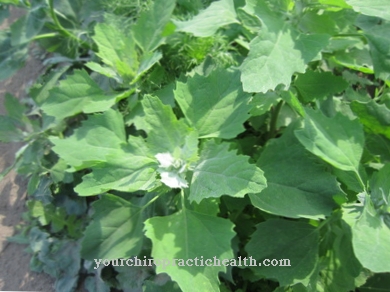The Garden report is also known as Spanish spinach or Spanish salad designated. For many, the plant is no more than a weed, and the vegetables are not only healthy, but also tasty. It is a close relative of spinach and is packed with nutrients.
What you should know about gardening reports

The botanical name of the Gartenmelde is Atriplex hortensis. It belongs to the foxtail family (Amaranthaceae). It is also one of the oldest cultivated plants and is also used as a salad and ornamental plant. In 2000 it was named Crop of the Year by the Nature Conservation Union in Germany.
The annual herbaceous plant grows up to 2.5 meters high. The stem is erect and striped with green. It is often branched out and square. The above-ground parts of the plant have a floured surface and the edge of the leaves is either whole or toothed. Because of its weight, the fruit cluster is often overhanging. The seeds of the Gartenmelde are either yellow-brown or black, with the black variant only germinating after two years. In our latitudes, the Gartenmelde blooms between July and September. The garden report is pollinated by wind or self-pollination. Some insects also distribute the pollen.
Judging by archaeological finds, the Gartenmelde was already known to the ancient Greeks. It was grown as far as Tibet and Bengal. The wild form also occurs in Central Asia. Like Swiss chard, the vegetables were brought to Central Europe by the Romans. In the 13th century, spinach replaced the garden log as a food.
In the Rhineland in particular, however, it is still used in the kitchen to this day. It tastes a little bitterer than spinach, but is all in all milder. Otherwise, the taste is similar to its relative. The garden notification is seasonal in the summer months. It can be harvested from May, although it can also be found in greenhouses and is therefore available all year round. There are different varieties to be found, the leaves are either blue-green or reddish in color. The leaves are bare on the underside and have fine hairs on the top.
Importance to health
Much like spinach, garden log also brings some healthy nutrients with it. The iron content is lower than that of its relative, but not to be despised either. The garden log is a blessing, especially for the muscles and nerves, as it has a high magnesium content.
There are also a number of vitamins that help meet the daily requirement. The vitamin A content is higher than that of spinach, while the vitamin C content is only half as high. Nevertheless, the garden report is a welcome and healthy change. In folk medicine, the message is even used externally. In the form of envelopes that are smeared with the pulp of the leaves, Gartenmelde helps against bruises and inflammation in this form. In addition, the leaves and seeds were used as emetics and laxatives. The plant stimulated the metabolism and was also used against nervousness. In folk medicine, the garden report was also used for lung diseases.
Although the vegetables in their wild form mainly grow on walls, on debris and on hedges, they are by no means to be despised and offer an alternative to spinach.
Ingredients & nutritional values
The vegetables contain both carbohydrates and proteins. 100 grams of the leaves contain around 3 grams of carbohydrates and 2.3 grams of protein. In addition, the plant only has around 26 calories in the same amount, which is why it is particularly suitable for figure-conscious people. The fat content is just 0.3 grams. There are also around 3 grams of fiber in 100 grams.
In addition, vitamins C and B are contained in the garden report. It also contains minerals such as potassium, calcium, magnesium and iron. The ingredients are responsible for the laxative effect of the garden message. For this reason, it should only be enjoyed in small amounts at best.
Intolerances & allergies
Food intolerances or allergies can occur again and again. However, these rarely occur with various types of vegetables, including the Gartenmelde. Much more it can lead to overreactions of the digestive system with excessive consumption.
Some people may be sensitive to the vegetables and expect flatulence or diarrhea. All in all, the garden report is mostly well tolerated. In absolutely exceptional cases, pollen allergy sufferers can develop cross allergies.
Shopping & kitchen tips
The Gartenmelde can be found at weekly markets, for example, under the name "Rheinische Gartenmelde" and is grown both outdoors and in greenhouses.
It can also be collected in nature by those who are knowledgeable, as there are wild forms to this day. The shape and color of the leaves are quite characteristic, which is why confusion rarely occurs. However, the vegetables are not really suitable for storage. After collecting or shopping, it should be used as soon as possible. Otherwise it will go bad quickly. However, the garden report can be kept in the vegetable compartment of the refrigerator for a day or two.
The preparation and preparation of the vegetables is similar to that of fresh spinach. The young leaves can also be used raw in salads. It is best to use young plants that are no more than eight inches high. Its leaves are particularly tender and can also be eaten raw.
Preparation tips
They are also suitable for mixtures with leafy salads. Another option is to steam the garden log like spinach. It is suitable as an accompaniment to poultry, eggs, cereals or fish. Before serving, it is simply put in a saucepan with lightly salted water after washing. After the leaves have collapsed, they're done. The young shoot tips are also edible and contain a number of healthy nutrients.
In France, the Gartenmelde is eaten with sorrel. The color of the red leaves remains even after cooking, although it can be used to color soups. The leaves give dishes a pleasantly bitter taste. Many children prefer gardening spinach, which is probably due to the lower content of oxalic acid.
In addition, the garden log is used as a leaf decoration in salads. Otherwise it is suitable in all combinations and variations in which spinach is used. If the vegetables are too bitter for you, they can also be blanched. This reduces the bitter substances. The seeds can be roasted in the oven or in the pan. They are suitable as seasoning and can also be used for baking.
One idea for a recipe is, for example, to process the garden log into quiche. This also requires natural yoghurt, paprika, vegetable broth, onions and sheep cheese.
























.jpg)



